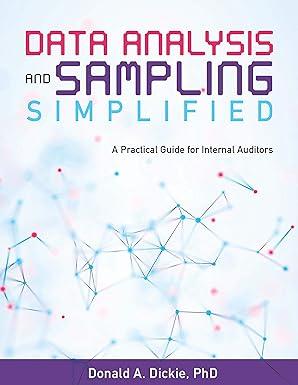Question
[Auditing] Listed below are some of the key dates in the coronavirus CODIV-19 timeline as documented by The New York Times. 12/31/19: The government in
[Auditing] Listed below are some of the key dates in the coronavirus CODIV-19 timeline as documented by The New York Times.
12/31/19: The government in Wuhan, China, confirms that authorities are treating dozens of cases. 01/20/20: The World Health Organization reports the first confirmed cases outside mainland China. 01/23/20: Chinese authorities close off Wuhan. 01/30/20: The World Health Organization declares a global health emergency. 02/24/20: The Trump administration asks Congress for $1.25 billion to fund response measures. 03/13/20: President Trump declares a national emergency. 03/27/20: Congress passes and President Trump signs a $2 trillion stimulus bill.
Not included in the above timeline are the dates that state and local governments began closing schools and businesses. In North Carolina, for example, school and business closings began on March 23, and Gov. Cooper issued a stay home order for all state citizens on March 27. As a CPA, you are the professional responsible for making a judgment about the reporting consequences of the coronavirus, regardless of whether you are doing so as an internal accountant preparing your employers financial statements or an external accountant auditing those financial statements.
RequiredStudy the topic of subsequent events by reference to the textbook, the AUD materials, and the only authoritative source on all financial accounting topics for nongovernmental entities, the FASB ASC. (A free version of the Codification labeled the Basic View is available at the FASB website.) Then consider the calamitous effects your employer or client is facing as a result of the coronavirus: Under U.S. GAAP, which type of subsequent event, if either, is the coronavirus considered to be?
Provide a brief, clearly articulated explanation to support your conclusion for each of the following scenarios: 1. The financial statements of your employer/client are for the fiscal year ended December 31, 2019. 2. The financial statements of your employer/client are for the fiscal year ended January 31, 2020. Assume that the financial statements are in draft form and are expected to be finalized by the end of April.
Step by Step Solution
There are 3 Steps involved in it
Step: 1

Get Instant Access to Expert-Tailored Solutions
See step-by-step solutions with expert insights and AI powered tools for academic success
Step: 2

Step: 3

Ace Your Homework with AI
Get the answers you need in no time with our AI-driven, step-by-step assistance
Get Started


